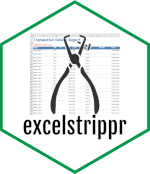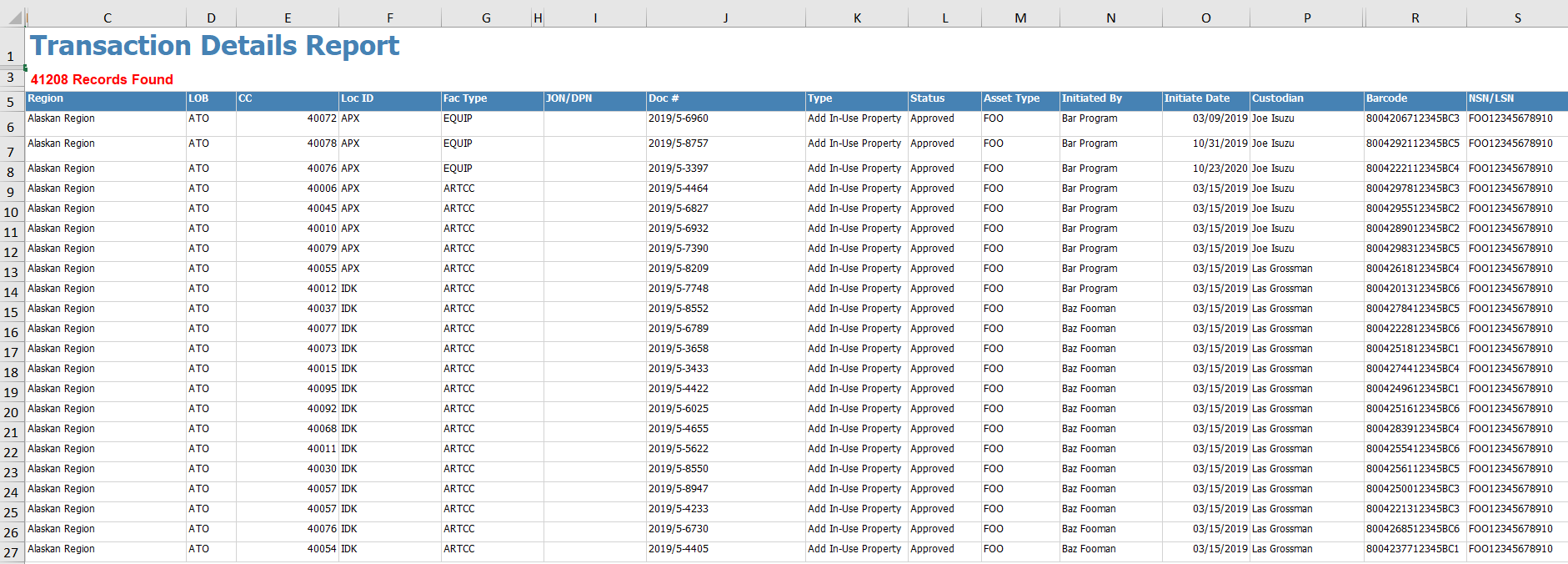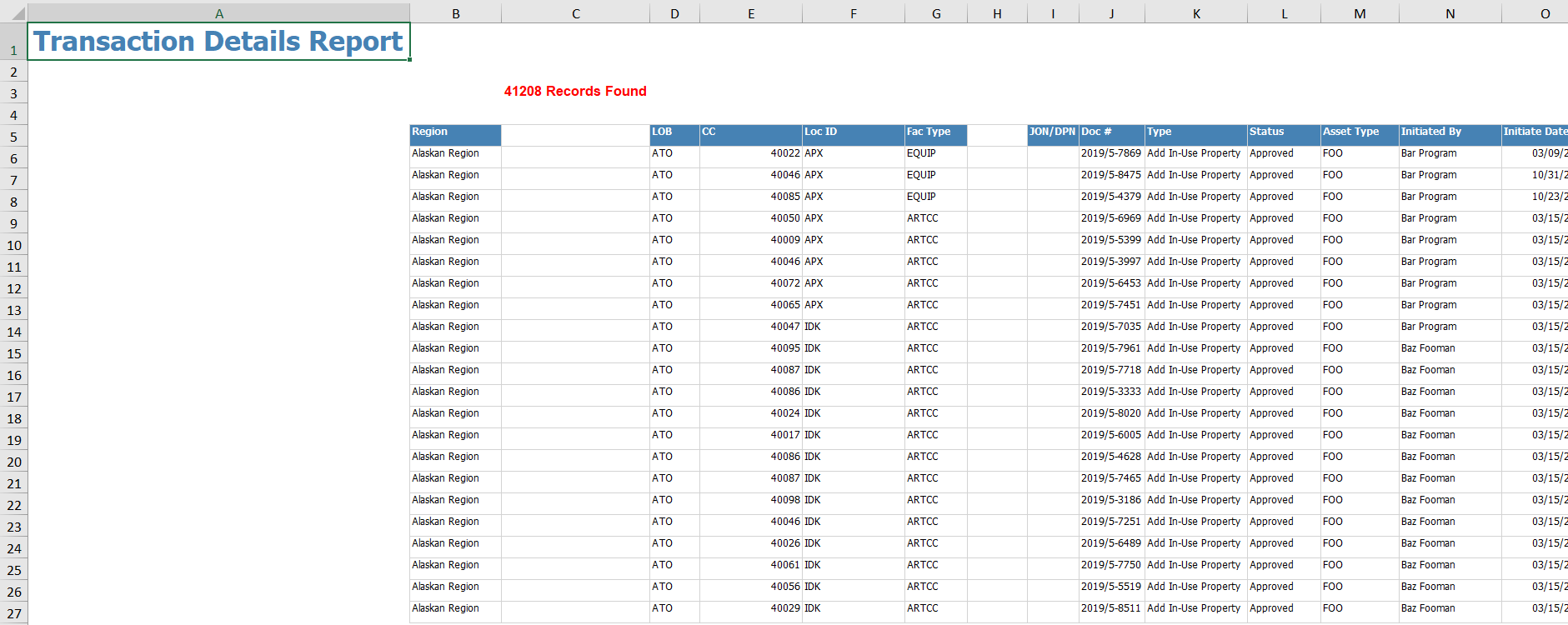

The goal of excelstrippr is to provide an easy way to remove the extraneous metadata, headers, summaries, etc., and extract the useful tabular data from Excel-based reports.
Excel reports often contain titles, data summaries, line counts, empty columns, etc., which make importing them into R a troublesome process. As there is no universal Excel report format, it’s difficult to write a reusable script to munge and import the data from these reports.
An example Excel report might look like this:

Unhiding hidden elements and adjusting empty columns to make them more clear shows that this report isn’t in any kind of standard tabular format:

When this data is imported into R, the results are not useful without serious wrangling:
dat <- readxl::read_excel("./man/example/example-report.xlsx")
#> New names:
#> * `` -> ...2
#> * `` -> ...3
#> * `` -> ...4
#> * `` -> ...5
#> * `` -> ...6
#> * ...
head(dat, 10)
#> # A tibble: 10 x 28
#> `Transaction De~ ...2 ...3 ...4 ...5 ...6 ...7 ...8 ...9 ...10 ...11
#> <lgl> <chr> <chr> <chr> <chr> <chr> <chr> <lgl> <chr> <chr> <chr>
#> 1 NA <NA> <NA> <NA> <NA> <NA> <NA> NA <NA> <NA> <NA>
#> 2 NA <NA> 4120~ <NA> <NA> <NA> <NA> NA <NA> <NA> <NA>
#> 3 NA <NA> <NA> <NA> <NA> <NA> <NA> NA <NA> <NA> <NA>
#> 4 NA Regi~ <NA> LOB CC Loc ~ Fac ~ NA JON/~ Doc # Type
#> 5 NA Alas~ <NA> ATO 40022 APX EQUIP NA <NA> 2019~ Add ~
#> 6 NA Alas~ <NA> ATO 40046 APX EQUIP NA <NA> 2019~ Add ~
#> 7 NA Alas~ <NA> ATO 40085 APX EQUIP NA <NA> 2019~ Add ~
#> 8 NA Alas~ <NA> ATO 40050 APX ARTCC NA <NA> 2019~ Add ~
#> 9 NA Alas~ <NA> ATO 40009 APX ARTCC NA <NA> 2019~ Add ~
#> 10 NA Alas~ <NA> ATO 40046 APX ARTCC NA <NA> 2019~ Add ~
#> # ... with 17 more variables: ...12 <chr>, ...13 <chr>, ...14 <chr>,
#> # ...15 <chr>, ...16 <chr>, ...17 <lgl>, ...18 <chr>, ...19 <chr>,
#> # ...20 <chr>, ...21 <chr>, ...22 <chr>, ...23 <chr>, ...24 <chr>,
#> # ...25 <chr>, ...26 <chr>, ...27 <chr>, ...28 <chr>excelstrippr will look for the start of a tabular data set in an Excel file, ignoring titles, summaries, and other meta-data in the report.
library(excelstrippr)
dat_stripped <- strip_metadata("./man/example/example-report.xlsx")
head(dat_stripped, 10)
#> # A tibble: 10 x 24
#> Region LOB CC `Loc ID` `Fac Type` `JON/DPN` `Doc #` Type Status
#> <chr> <chr> <chr> <chr> <chr> <chr> <chr> <chr> <chr>
#> 1 Alask~ ATO 40022 APX EQUIP <NA> 2019/5~ Add ~ Appro~
#> 2 Alask~ ATO 40046 APX EQUIP <NA> 2019/5~ Add ~ Appro~
#> 3 Alask~ ATO 40085 APX EQUIP <NA> 2019/5~ Add ~ Appro~
#> 4 Alask~ ATO 40050 APX ARTCC <NA> 2019/5~ Add ~ Appro~
#> 5 Alask~ ATO 40009 APX ARTCC <NA> 2019/5~ Add ~ Appro~
#> 6 Alask~ ATO 40046 APX ARTCC <NA> 2019/5~ Add ~ Appro~
#> 7 Alask~ ATO 40072 APX ARTCC <NA> 2019/5~ Add ~ Appro~
#> 8 Alask~ ATO 40065 APX ARTCC <NA> 2019/5~ Add ~ Appro~
#> 9 Alask~ ATO 40047 IDK ARTCC <NA> 2019/5~ Add ~ Appro~
#> 10 Alask~ ATO 40095 IDK ARTCC <NA> 2019/5~ Add ~ Appro~
#> # ... with 15 more variables: `Asset Type` <chr>, `Initiated By` <chr>,
#> # `Initiate Date` <chr>, Custodian <chr>, Barcode <chr>, `NSN/LSN` <chr>,
#> # Description <chr>, `Serial #` <chr>, `Delphi Asset #` <chr>, Cost <chr>,
#> # Qty <chr>, `Rejected By` <chr>, `Rej Reason` <chr>, `Rej Date` <chr>, `Test
#> # Equip` <chr>The extracted data can then be saved back into another file for future analysis or can be immediately used in analysis pipeline as any other data frame object.
You can install the released version of excelstrippr from CRAN with:
The most recent version of excelstrippr can be installed from GitHub with {devtools}: